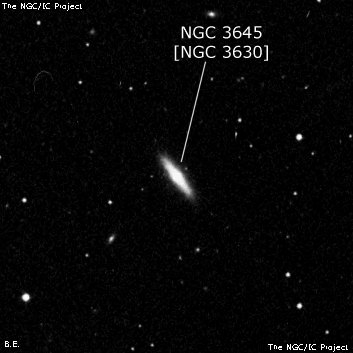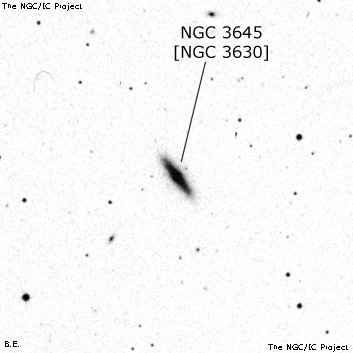NGC/IC Project Restoration Effort
(This is a very very beta version)
NGC3645


Basic Information
Location and Magnitude
Right Ascension: 11:20:16.9
Declination: +2:57:52
Constellation: LEO
Visual Magnitude: 12.0
Historic Information
Discoverer: Herschel W.
Year of discovery: 1784
Discovery aperture: 18.7
Observational
Summary description: pB, S, E, bM
Sub-type: S0-a
Corwin's Notes
=====
NGC 3645. This, and five other NGC/IC objects (N3643, N3644, and N3647, which
see; and I683 and I684), lie in a relatively crowded field. There has been
considerable confusion about the identifications here because of the crowding
-- and because the NGC position of the (presumeably) brightest object, N3645,
lies in a blank area of sky a few arcminutes northwest of the group center.
This brightest object was found first by William Herschel on 23 Feb 1784. He
placed it 6m 30s preceding and 7' north of 84 (tau) Leo. The NGC position
comes from John Herschel's single uncertain observation during Sweep 143; the
object is h867 in his 1833 list, though he notes both it and h861 as being II
32. This latter object is considerably brighter than any of the galaxies in
the group, and precedes it by 1.3 min. JH saw it during two sweeps (141 and
238), but did not pick it up during Sweep 143. Similarly, h867 was seen only
during Sweep 143, but not during sweeps 141 and 238. That, combined with the
relative brightness of the object compared to those in the group and JH's
uncertain position for h867, strongly suggests that h867 = h861; i.e. N3645 =
N3630.
N3645 is also credited to Tempel who has a long discussion of the field in AN
2212 (pp.51-2). I've not translated this yet, but I do not easily see any
precise offset from a known object in the text. Is it possible that Tempel
was misled by JH's attribution of H II 32 to two different objects? A
translation is clearly needed.
Steve's Notes
=====
NGC 3645
See observing notes for NGC 3630.



